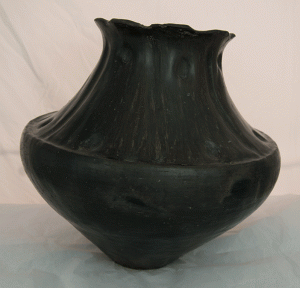Santa Clara potters have a long history of pottery making and have become famous as innovators. They are masters of form. There are more than 200 active Santa Clara potters. Until the 1920s, a majority of Santa Clara pottery was undecorated redware, blackware or was made of a natural micaceous clay. They have developed famous techniques and their pottery decoration has become a hallmark of the pueblo. Today, the Santa Clara Potters are constantly modifying their traditions. Potters have been experimenting with their art for years; they have created the field of miniatures (Batkin, 1987).
 Lela Gutierrez (1895-1966) and Van Gutierrez (c.1870-1956) Vase, c. 1930s/40s. Red, tan, brown, orange, blue, black, and brown on red clay. 14.5 x 13 cm. (dia.) Gift of Dr. F. C. Spencer. 1945.1.32
Lela Gutierrez (1895-1966) and Van Gutierrez (c.1870-1956) Vase, c. 1930s/40s. Red, tan, brown, orange, blue, black, and brown on red clay. 14.5 x 13 cm. (dia.) Gift of Dr. F. C. Spencer. 1945.1.32
Lela and Van Gutierrez modified a polychrome method that was already in their family. They tested many ideas in pottery making, developing a decorative scheme that featured earth colors on a matte background. Using bold curvilinear designs on neutral tan or beige became the base for a new Santa Clara style. This resulting style of the Gutierrez family is so distinctive, it is uniquely their own. The Gutierrez’s used a rag to polish their pots instead of a stone, giving their pots a silky feel rather than the mirror-like brilliance of stone polish. Lela and Van were true innovators and specialized in pictorial designs in using a variety of hues and colors not normally associated with pueblo pottery (Trimble, 1987).

Signed on bottom of pot in black paint: “Lela” / “Van”
Margaret and Luther Gutierrez have carried on the work of their parents as well as Luther’s granddaughter Stephanie. The unique style of the Gutierrez family spans four generations (Trimble, 1987).

Olla, c. late 1800s. Red clay, reduction fired, incised, polished. 29.5 x 31.5 cm (dia.). Gift of Mrs. Charles H. Woodard. 1965.1.19
Up to about 1900 vessels were made with the smudging technique. The jars have a concave base, widely flaring low underbody, mid-body bulge, rather tall, slender neck with a pronunced flare at rim. The departures from the tradition can been seen in this olla. Sculptural detail embellishes the vessel with a fluted rim, the neck is rippled with vertical carvings, and the mid-body is made with a bulge (Frank & Harlow, 1990). European influence is seen in the fluted rim.

Santa Clara Pueblo. Tea Pot, c. 1920s/30s. Red clay, reduction fire. 12 x 23 cm. Gift of Dr. F. C. Spencer. 1945.1.33
BIBLIOGRAPHY
Batkin, Jonathan. Pottery of the Pueblos of New Mexico 1700-1940. The Taylor Museum of the Colorado Springs Fine Arts Center. 1987.
Frank, Larry and Francis H. Harlow. Historic Pottery of the Pueblo Indians 1600-1880, Schiffer Publishing Ltd. 1990.
Trimble, Stephen. Talking with the Clay: The Art of Pueblo Pottery. School of American Research Press. Santa Fe, New Mexico.1987.
